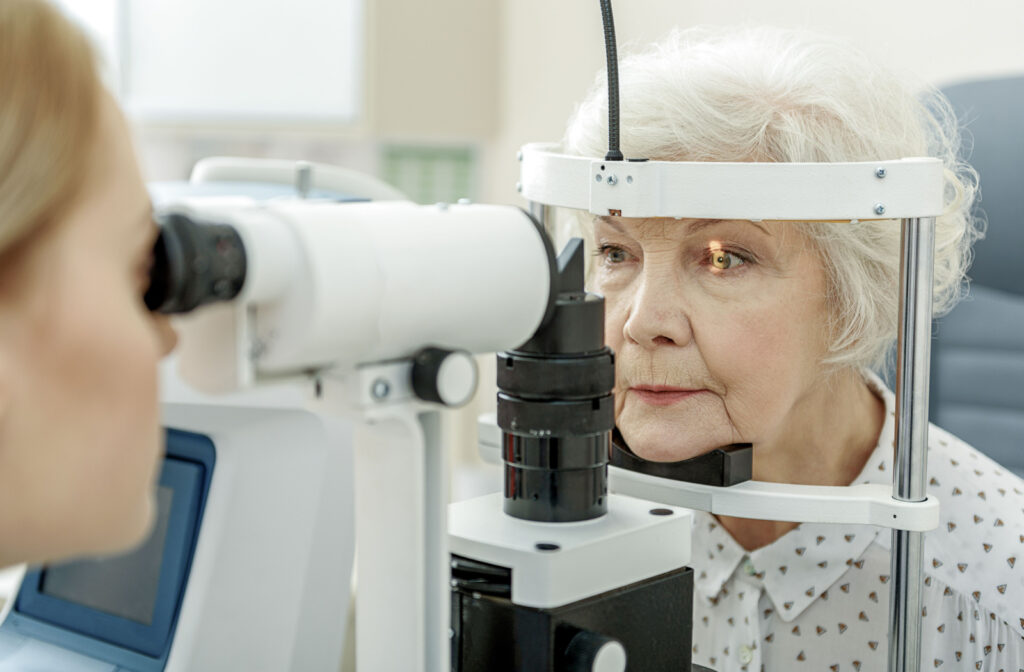Clear vision is a treasured sense: a gateway to our world and an informer of experiences. It sounds dramatic, but we rely on our vision for so much, and it’s easy to take it for granted. However, 2 common eye conditions, cataracts and glaucoma, can cloud our vision if left undetected and untreated. While they can affect your vision similarly, they’re very different diseases.
The main difference between the pair is that cataracts are the natural clouding of the eye’s lens, while glaucoma involves damage to the optic nerve, typically due to increased eye pressure. However, one thing they have in common is your optometrist can detect both with a comprehensive eye exam.
What Are Cataracts?
Cataracts are a leading cause of vision loss in Canada. They cause the eye’s lens to become cloudy, which then causes light to scatter across the retina and results in blurry vision. The primary culprit behind cataracts is protein buildup in the lens, which happens naturally as we age.
However, other factors can cause cataracts to develop early or with greater severity, including:
- Genetics
- Eye injury
- Diabetes
- Obesity
- UV exposure
- Smoking
- Excessive alcohol consumption
- High blood pressure
- Glaucoma or retinal eye surgery
- Medications, such as steroids
Think of cataracts as a slow progression, gradually dimming your perception like an aging photograph.
Cataract Symptoms
The symptoms of cataracts may vary considerably, but common signs include:
- Blurred vision
- Sensitivity to light
- Seeing halos around lights
- Colours appearing faded
Cataract symptoms can progress, affecting night vision and leading to significant vision complications if left untreated.
Treatments for Cataracts
The good news about cataracts is they’re treatable. Diagnosis typically begins with a comprehensive eye exam that may include dilating your pupils to allow your eye doctor to examine the lens for any signs of cataracts.
Optometrists can address early symptoms with prescription eyeglasses. Once cataracts start severely affecting your vision, you may require surgery to remove the cloudy lens and replace it with an artificial one.
What Is Glaucoma?
Glaucoma, on the other hand, isn’t a single condition but a group of eye diseases that damage the optic nerve, often due to elevated pressure in the eye. Glaucoma is challenging because it can sneak up on you without warning, silently eradicating your peripheral vision. Symptoms might not manifest until the disease has progressed and damage is done.
There are several types of glaucoma, but the most common varieties include:
- Open-angle glaucoma: In open-angle glaucoma, the eye structures appear normal, but the fluid does not flow out properly, causing a pressure buildup. This makes up about 90% of all glaucoma cases.
- Angle-closure glaucoma: Angle-closure glaucoma occurs when the iris is very close to the drainage angle in the eye and can block fluids from draining.
- Secondary glaucoma: Secondary glaucoma results from injury, surgery, infection, or other eye abnormality.
- Normal-tension glaucoma: While glaucoma is usually caused by increased pressure inside the eye, normal-tension glaucoma occurs when eye pressure is still in the “normal” range.
Risk Factors for Glaucoma
Since glaucoma can be so stealthy, knowing the risk factors helps determine if you need to be on the lookout. Risk factors for glaucoma include:
- Age
- Family history
- Cardiovascular conditions
- Eye-related health conditions
- Injury or eye surgery
There’s no turning back the clock on vision loss—so early detection is paramount. Regular check-ups with an optometrist can make all the difference.
Glaucoma Diagnosis & Management
Like cataracts, diagnosis involves a full eye exam focusing on the optic nerve. Tonometry is a common test, using a puff of air or a gentle probe to test your eye pressure. If diagnosed, your doctor can try to manage glaucoma’s progression through medication, laser treatment, or, if necessary, traditional surgery.
The key for most treatments is keeping eye pressure stable to avoid optic nerve damage.
The Differences Between Cataracts & Glaucoma
Cataracts and glaucoma are both conditions that can slowly rob you of your sight, but they have different mechanics and, therefore, treatments.
Cataracts are a natural part of aging, like hair turning grey. Environment and genetic factors can affect when they first appear, but treatment with cataract surgery is very common.
Glaucoma is typically associated with increased eye pressure and usually means there’s something wrong with your eye. Once the damage is done, it can’t be reversed. This means that much of the focus for glaucoma is on preventing vision loss or preserving what vision remains.

Proactive Prevention & Early Detection in Cochrane
Though both serious, cataracts and glaucoma are markedly different in their nature and impact on our vision. Understanding where these conditions diverge is the first step in taking control of your eye health.
Routine eye check-ups can often be the difference between suffering from a vision-related issue and proactively addressing it before it’s too late. Our River Heights Eye Care team can detect issues early on with annual comprehensive eye exams, allowing you to adopt strategies to potentially slow them down. If you’re experiencing any changes in your vision or are at a higher risk for these conditions due to your age or medical history, book your eye exam today. Your eyes are with you for the long haul, so look out for them as they guide you through life’s wonders!


